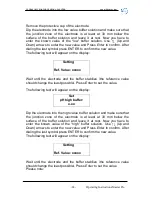
ULTRASONIC PORTABLE MILK ANALYZER
www.milkotester.com
-9-
Operating Instructions Master Pro
In summer the sample fills up to the top the vessel, but in winter
– at least 3/4 from the vessel’s volume. Each sample for analyses has
to be labeled and described in a way not allowing to be mixed up.
The samples are stored in conditions, assuring temperature,
corresponding to the requirements for storing such kind of product
(advisable – 1 °
С
).
If there is a need of longer sample storing they have to be
preserved; the most commonly used preservative is potassium
dichromate (K2Cr2O7) - 1 g for 1 000 ml. The samples have to be
stored in a cold and dark place after the preservation. Have in mind
that during the analyses the results for SNF% will be increased with
0,1 %. After adding the preservative the sample has to be well stirred.
Preparing the samples for analyses
Milk – raw and thermally treated
When examining samples taken immediately before analyses
and shortly stored, the milk is poured several times from vessel to
vessel in order to distribute the fat content uniformly. To avoid foam
formation or separation of milk fat, the samples have to be carefully
poured using the walls of the vessels, as they are tilted slightly. For a
better mixing the sample it has to be poured at least 3 times. When
needed the same is tempered to the temperature within the measuring
range.
If there is fat stuck on the walls of the vessel and the stopple
(when the samples were stored for a long time), the milk has to be
slowly heated up to 35-40 °
С
. At the same time it has to be slowly
shaken. The cream, stuck to the walls of the vessel is removed. The
sample is poured several times and is cooled down (advisable up to
20°
С
).
If there is separated liquefied fat or white particles with irregular form
on the vessel’s walls reliable results could not be expected.
Do not make analyses if the acidity of the milk is more than 17
o
T.










































